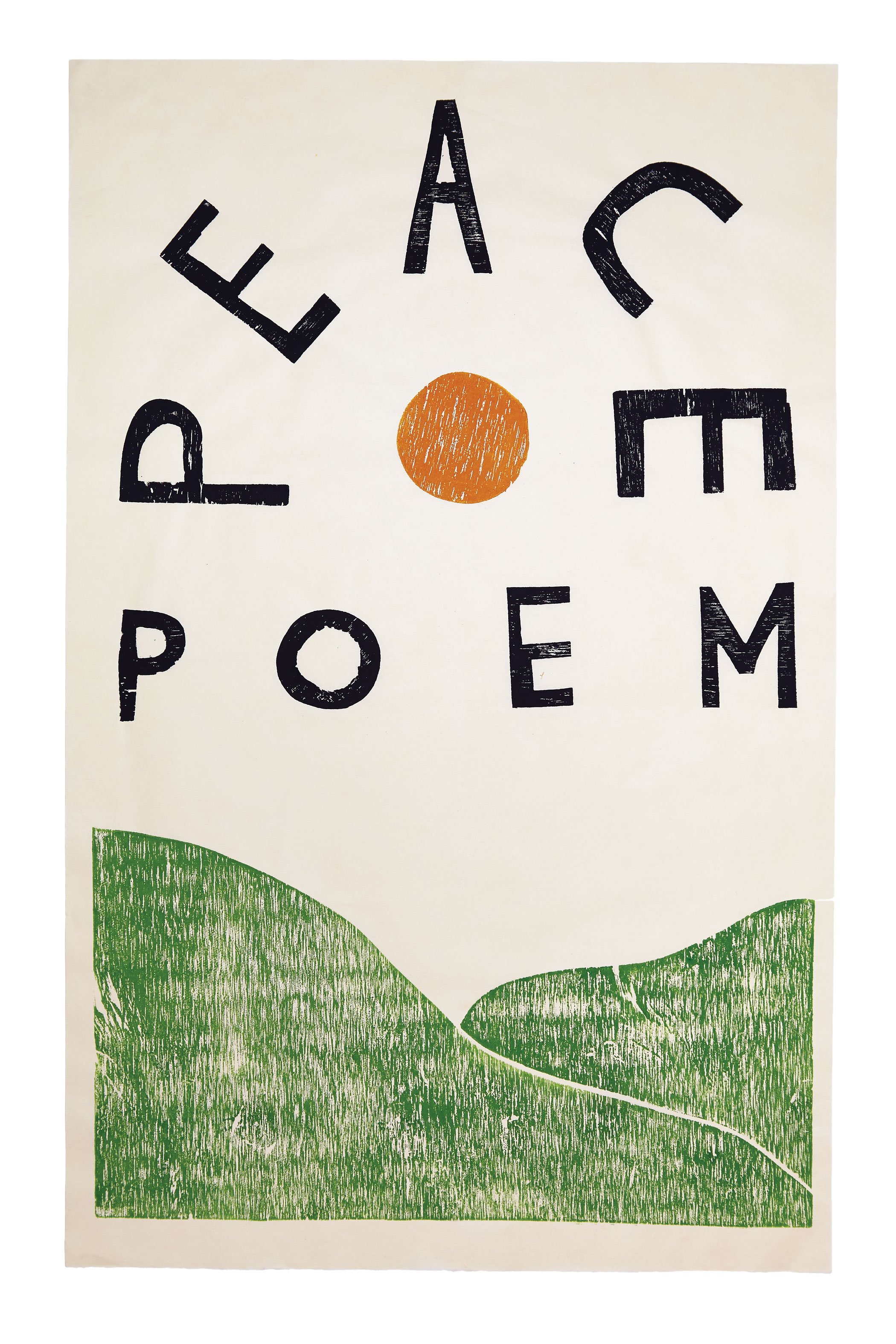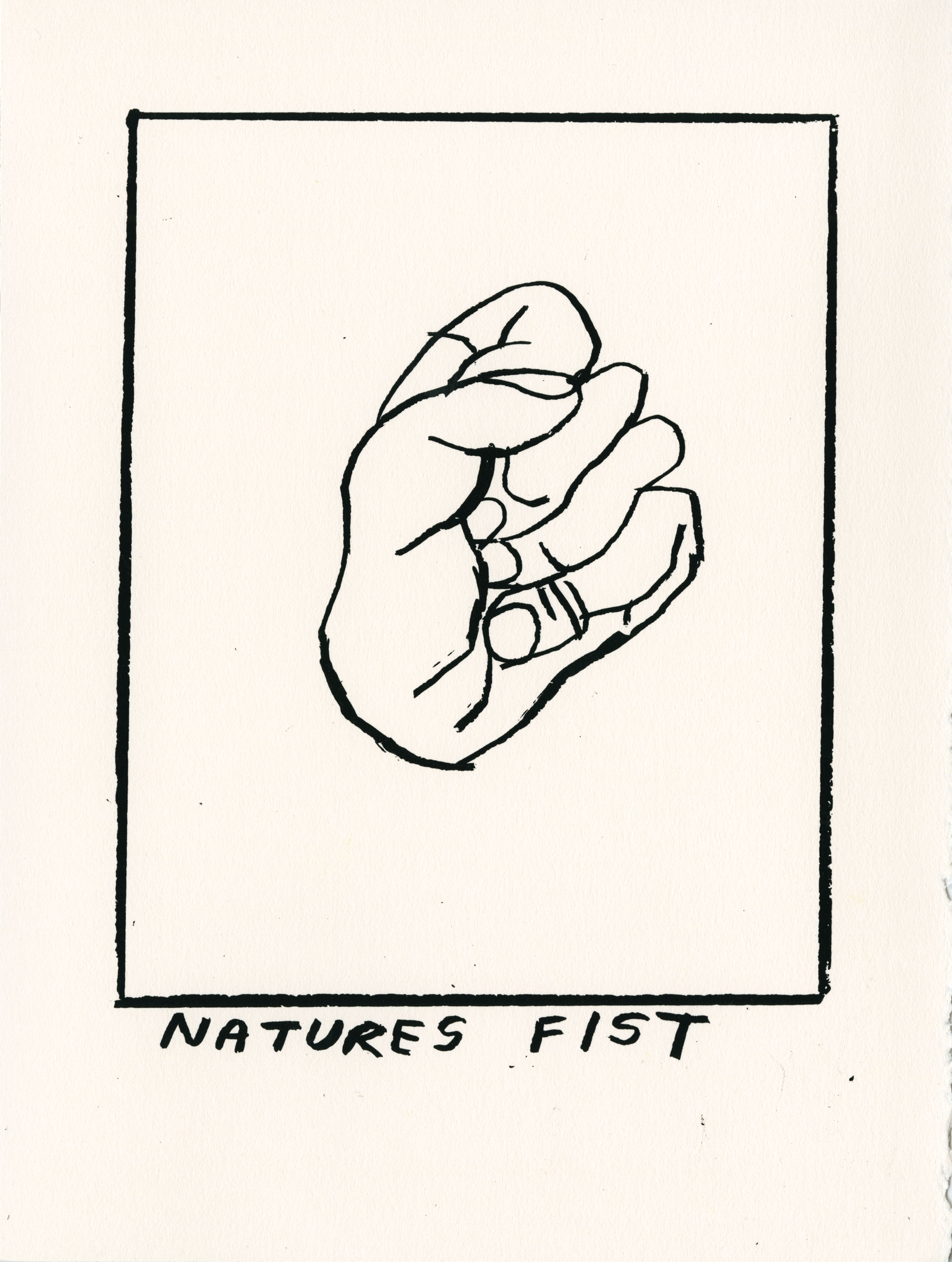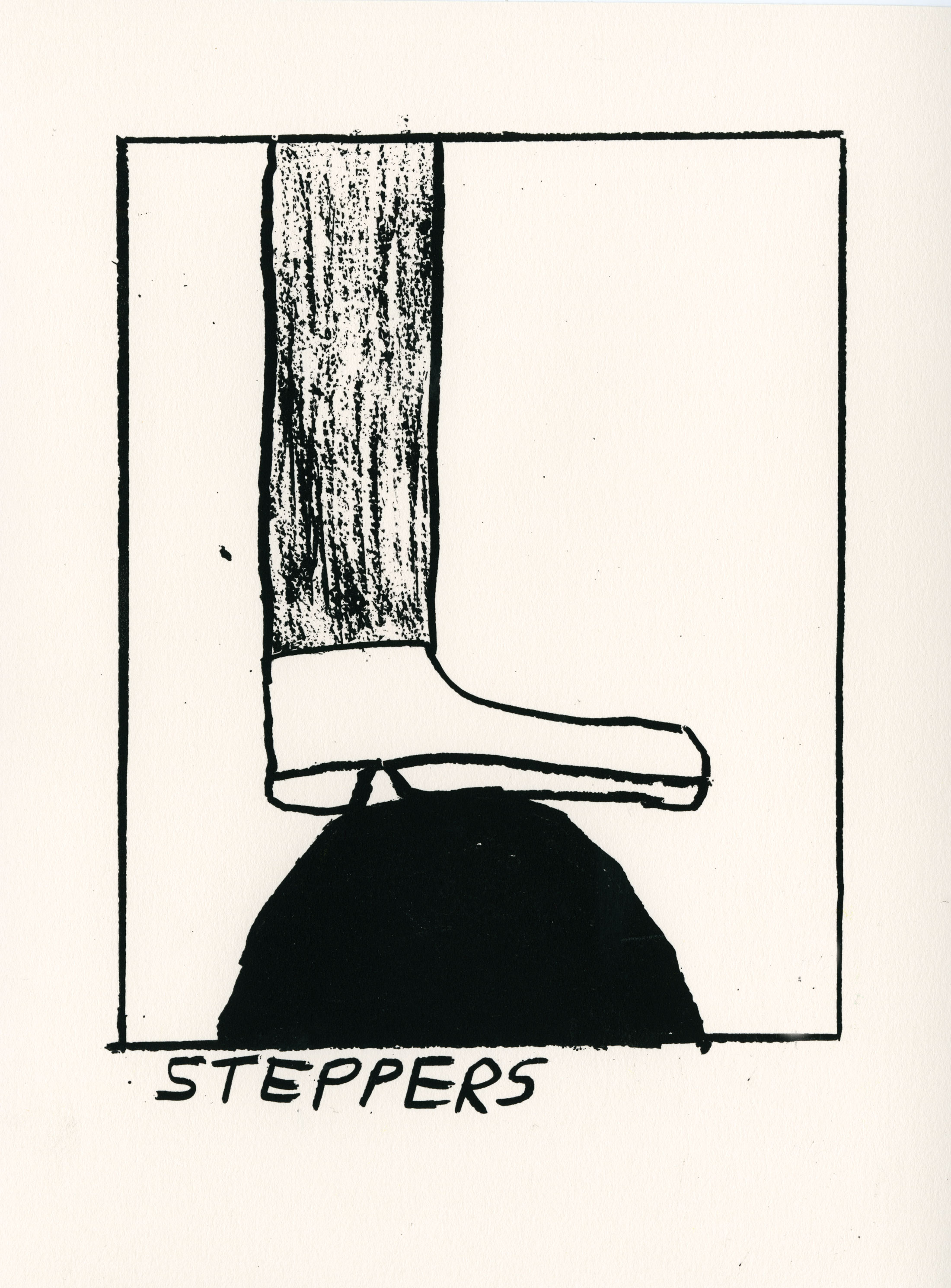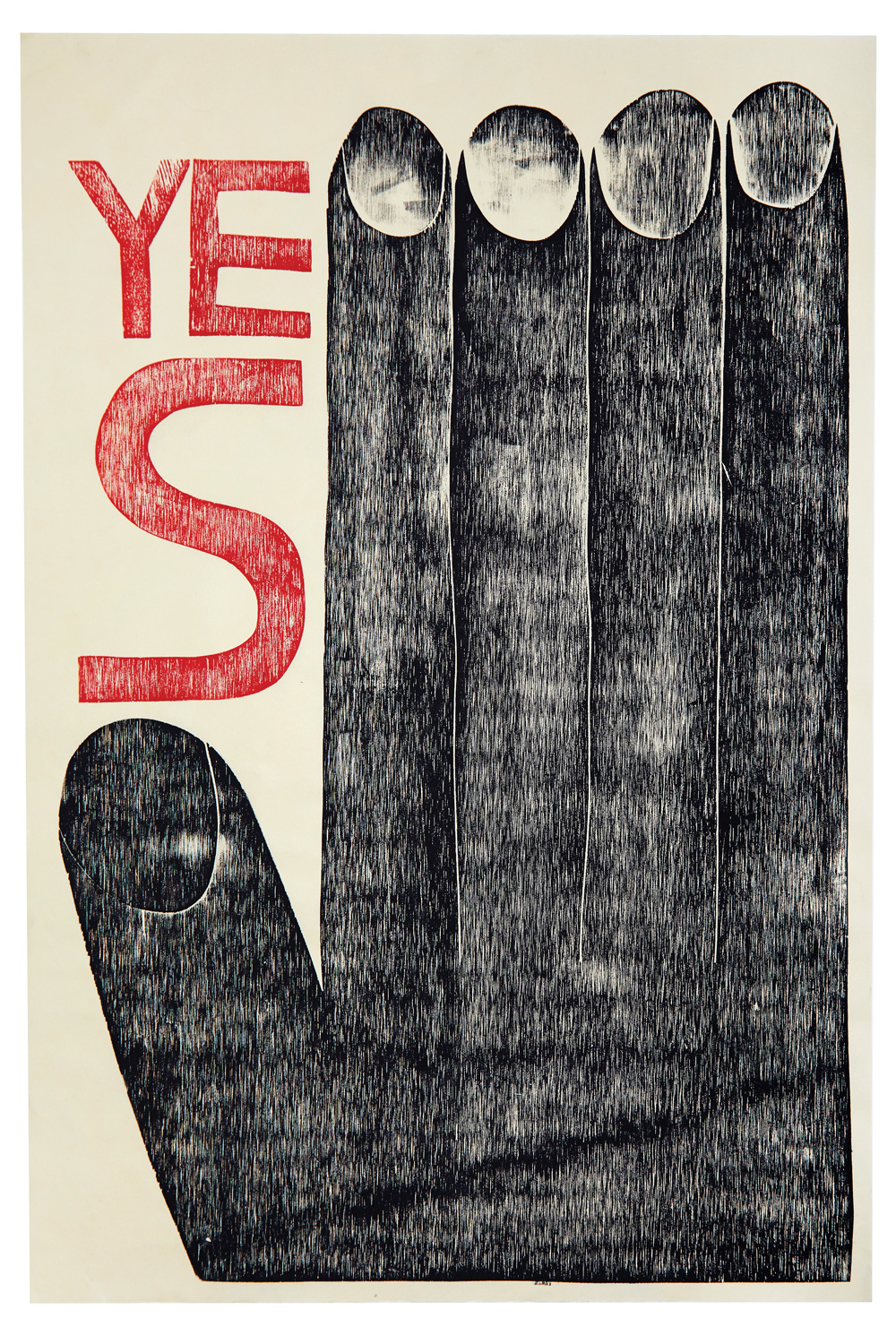This feature on Nathaniel was originally published in issue 18. You can buy the issue here.
“I try not to think about it too much and just do.”
For Indiana-based artist Nathaniel Russell, less is more. At once opinionated, earnest, and thought-provoking, Russell’s work employs heady notions about the rawness and honesty of being human, into seemingly simplistic paintings, drawings, sculptures, and prints that break things down to their essential colors and forms. With each piece, Russell performs a balancing act between the funny parts of being alive and the actually terrifying realities we’re all faced with each day. Often accompanied by words or phrases, his work is both sincere and deeply humanistic, shedding light on the man behind the work, someone who is just trying to figure it all out like the rest of us.
His approach of simplification — leaving out enough information in order to benevolently encourage the viewer to fill in the blanks — reveals the inclusivity of his work. How do you put less information into the work for maximum impact? How do you communicate an idea with the least amount of information? From the artwork he’s made for skate brands like Element and skateboarder Elissa Steamer’s Gnarhunters, to the psych-informed screenprints and paintings he creates with his trusted woodcut technique, Russell’s focus is on the idea that spawned the original drawing and visual, and framing it in an ambiguous, yet applicable way that provokes viewers to consider their place in the universe. His clever words and bold graphics illuminate sad truths of contemporary culture, but simultaneously beg us all to be better. With so many distressing circumstances in the world, Russell’s work is the much-needed voice in our ear whispering that all is not lost.

I know you grew up in Indiana, did you enjoy that? Tell me a little bit about your childhood.
I mean, yeah it’s great. I grew up on the southside of Indianapolis so at the time it was pretty suburban. I lived pretty close to like a mall and there was a creek close to my house that we’d go play around the creek. Once I got older I got into skateboarding and music. We’d just skate all over the place and go to the mall.
Were you at all in a rush to get out of those surroundings?
I think like any teenager, I was like, this is boring this sucks, but at the same time, I was really comfortable. There’s this doc on Netflix about Bob Dylan, Rolling Thunder Revue. In it, he says something like, “Life isn’t about finding yourself, it’s about creating yourself.” I found that pretty appropriate.
When did you pick up your first skateboard?
My mom wouldn’t let me have one for a really long time because she said they were dangerous. I would spend a couple of weeks with my dad every summer; he didn’t live that far away from me. There was a strip mall a mile from his house and I was really into comics and Mad Magazine, and I’d walk to that newsstand all the time and browse through the skateboarding magazines. I would buy those and devour them. I liked everything about what I was seeing in those magazines. After a while, I convinced my mom that I could handle it. I think she got tired of hearing me complain and got a pretty lame toy store skateboard. It was a Valterra meltdown skateboard. I blew through that pretty quickly and then I was finally able to convince my folks to get me a real skateboard at this skate shop called Maui and Sons. Which is really funny cause it was a surf shop in the middle of Indiana. I think it’s really popular now to be like, skateboarding changed my life, it informed everything I come from and everything like that but you know, in a way there really is truth in that statement. Skateboarding stuck with me my whole life, there’s nothing else I’ve really been into as long as that besides music. It changes the way that you perceive things.
Back then if you were a skateboarder, you were a part of something that no one else was a part of. You were at the bottom of the social totem pole.
Oh for sure, it was not “cool” in school. But that’s what was great about it because I wasn’t good at sports, I didn’t care about that stuff. I was into girls, but the girls weren’t into me. I was twelve years old. If you’re into Mad Magazine and weird late-night comedies there’s a certain subversive element in there that’s spinning this sentiment that all the jocks and “cool” people are actually not cool, they’re zombies. Skateboarding was an addition to that sentiment. I often wonder if I was a teenager and I wasn’t into skateboarding what the hell would I be doing with my time? I was spending the summer behind a strip mall with my friends, jumping off curbs and stuff.

When did you end up leaving Indiana?
I went to college in Indiana at a place called Ball State University. I wasn’t that into it for the first few years, and then I took a print-making class where I realized I was good at it. That was a huge moment for me. I got a job at an art supply store, started meeting people that worked there, and it opened my eyes to a different way of living. For lack of a better word, it was more of a bohemian art school style of living. It was no longer skating all night and eating McDonald’s and drinking Mountain Dew. It was, maybe I’ll go skate, but then we’re gonna start a band and we’re gonna eat this pesto my friends made from her garden. It was a cool way to grow older and get interested in more alternative ways of being. I eventually moved to Berkeley in 2000. I got a job at a record store and found a place to live. I made art at this print-making center, worked at this record store, and learned a lot about music. At the time, I was really focused on making music. I made drawings, but I wanted to write songs and be in a band.
What kind of music were you making at the time, did you move to Berkeley knowing people?
I had some friends from college that lived in El Cerrito by the 80. They were nice and foolish enough to say that I could sleep on their couch. When you get to the Bay Area, right as you get over the 80, over the Sierras, it smells different. It smells like California. I spent my time cruising around and getting lost on the way to work. Eventually, I found a place with a few other guys that became my lifelong brothers. We really encouraged each other with music and art, and stayed up late talking about Berkeley stuff, philosophy and Beatles records. I don’t think I turned on the television for three years.
Were you checking in on the art scene as well? I feel like skateboarding and art, especially in the Bay Area at this time [the early 2000s], went hand in hand.
I would go to the MOMA every now and then, and it was right when a lot of stuff was happening in the Mission with Barry McGee, Margaret Kilgallen, and Chris Johanson. I would stumble into Jack Hanley Gallery and be taken back by the work. Or I would see some Barry piece on the wall that spoke to me, but I didn’t know. It sounds ridiculous, but at that time, there wasn’t an art genre for me that I could fully engage in.
A friend started a record label and wanted to do a series of 7 inches, my band being the first one. I was teaching a workshop on letterpress at the center, so I would go in there and run off five hundred copies of a record sleeve. I only wanted to make record sleeves and posters and would offer to do so for anyone that came into the record store. I got hip to things happening in Oakland and remember throwing a big group show together with a friend and organizing it in a warehouse in Oakland. We put all our friends in it. We ended up living in a warehouse together and it all kind of snowballed. That’s how the art and music scene world that I fit into works. You ask your friend to be in an art show, you get to be in a show because of them, and then years later they have their own residency program and you go do their residency.

Build your community, work together, and continue to bring each other on different projects.
Yeah, you take advantage of these opportunities to work with your friends and bring people whose work you respect into the fold. You continue to pass this energy around. Why else are you doing this if you can’t make it worthwhile and valuable on a spiritual level? The huge benefit of it, you get to work with your friends for the rest of your life.
Do you remember when you first started putting your artwork into the world?
As far as putting myself out there at the level I wanted, was when I started working with Mollusk in San Francisco around 2005. They had a small gallery in the back and I did a bunch of ink drawings. It was a really modest show—thirty ink drawings. I framed everything the night before and made all the frames myself, but I bought the wrong kind of wood so it was really difficult; my hands were all bloody. I probably did all the drawings in the two weeks beforehand.
You’re still doing woodcut prints, and flyers in a different way. How do you think your practice has evolved over the years?
Everything comes in cycles. I didn’t do woodcuts for a long time, then I started doing them again. It’s whatever medium fits the idea. Woodcuts have a deceptive process—it looks easy and simple but when you’re wrestling with that medium and the printing process is so full of subtleties and actual physical labor, it’s really difficult. What I’ve said before is, you know when a guitar player plays through a distortion pedal and they get that crazy fuzz tone? I feel like doing a woodcut is like you pushing your drawing or your idea through the woodcut pedal. It becomes something other than what you thought. What I love about printmaking with silkscreen and woodcut is the democratic nature of it. You can make silkscreens and sell them relatively inexpensively. That’s really important to me and I try to keep those things cheap so that people can buy art if they want to. It’s hard for me to justify selling a $5,000 painting. I’ve done it, I love it, it’s great but I want to make things for everyone. I want to get ideas out and a lot of my ideas are served with that printmaking medium. My work has evolved in a way that I’m trying hard to do less. Put less information into the work for maximum impact. How do I communicate an idea with the least amount of information? How do I make a line without drawing a line?

Do you feel like art is still a huge mystery to you?
Yeah, why do I respond to certain things? Why is this shape exciting to me? And also to other people? There are these unarticulated and untapped receptors in our brains that process that information that is beyond language but is universal or common to all humans. That’s why certain music, art, and movies resonate with people. That links us all. We’re all responding to this shape or we have this common vibration that’s happening and that’s what is part of what makes us uniquely human, and it’s still this huge mystery.
Do you see yourself as a political artist at all? Or are you simply making commentary on the things around you?
I’ve never thought of myself as making commentary on anything other than my thoughts. I’m usually thinking about death and life and what it is to be a human and what’s important. What I’m thinking about is how fucked things are and how terrifying everything is. I have a couple of kids, so I’m freaked out and trying to suss all this stuff out. I don’t feel great coming out with a piece of work of me kicking Trump in the face. I totally have made a drawing like that before, but I’m trying to articulate this feeling of rage and terror in a more ambiguous way. It’s more about the feeling than the specific villain. My work isn’t really about confronting the devil, it’s about the fact the devil exists.
For more from Nathaniel Russell, follow him on Instagram.
